The black-headed grosbeak (Pheucticus melanocephalus) is a member of the Cardinalidae family. It boasts striking yellow, orange, white, and black plumage and prefers the thick protection of conifer forests. The black-headed grosbeak is the only breed of songbirds that can stomach the toxic chemical in Monarch butterflies.
The black-headed grosbeak’s bright and distinctive features make them easy to spot by birdwatchers. While they spend their breeding season in the western portion of the United States, these short-distance migrants flock to Mexico in early July for their wintering grounds.
If you want to see this shy and elusive songbird, understanding their breeding habits, migration patterns, and habits is critical.
What do the feathers on a Black-Headed Grosbeak look like?
Their bright and distinctive features make them easy to spot by birdwatchers. Adult male black-headed grosbeaks have bright orange, yellow, black, and white patches in their underparts with a unique black cap. They have black and white wing bars with touches of yellow under their wings.
When in flight, these showy songbirds look like streaks of yellow across the sky and often sing mating calls.
Like a cardinal, black-headed grosbeaks have a conical-shaped silver and black bill for dining on insects and sunflower seeds.
Female black-headed grosbeaks and juveniles don’t have the same show-stopping feathers as their male counterparts. At a glance, the muted cinnamon coloring of the females looks very similar to a house sparrow. They have black wings with hints of white and cinnamon brown underparts.

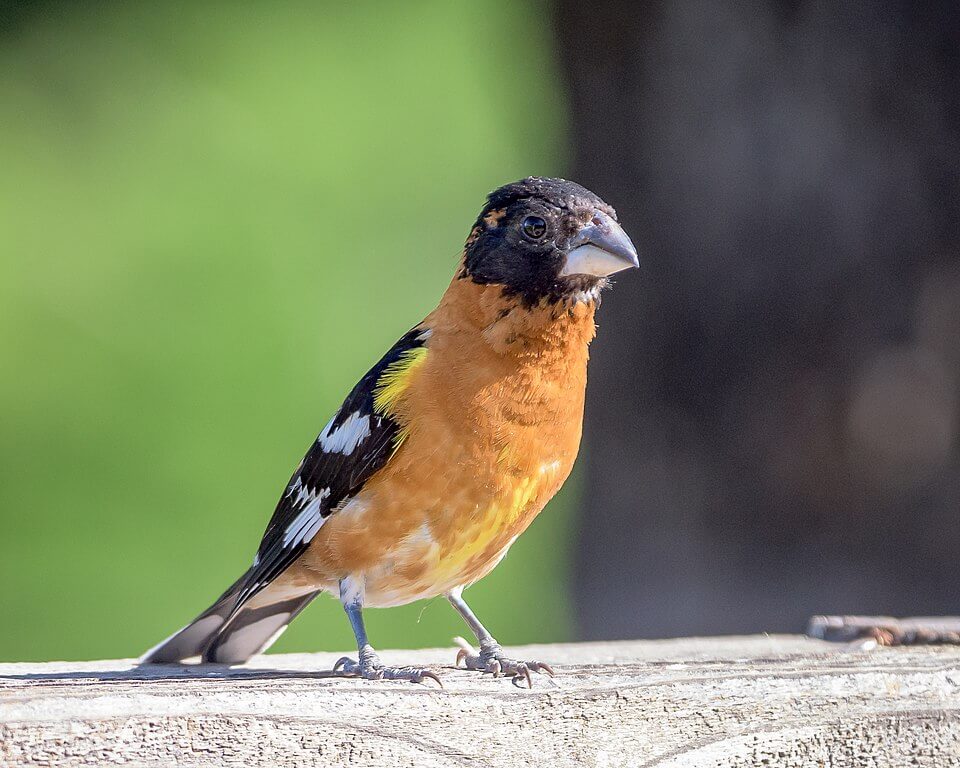
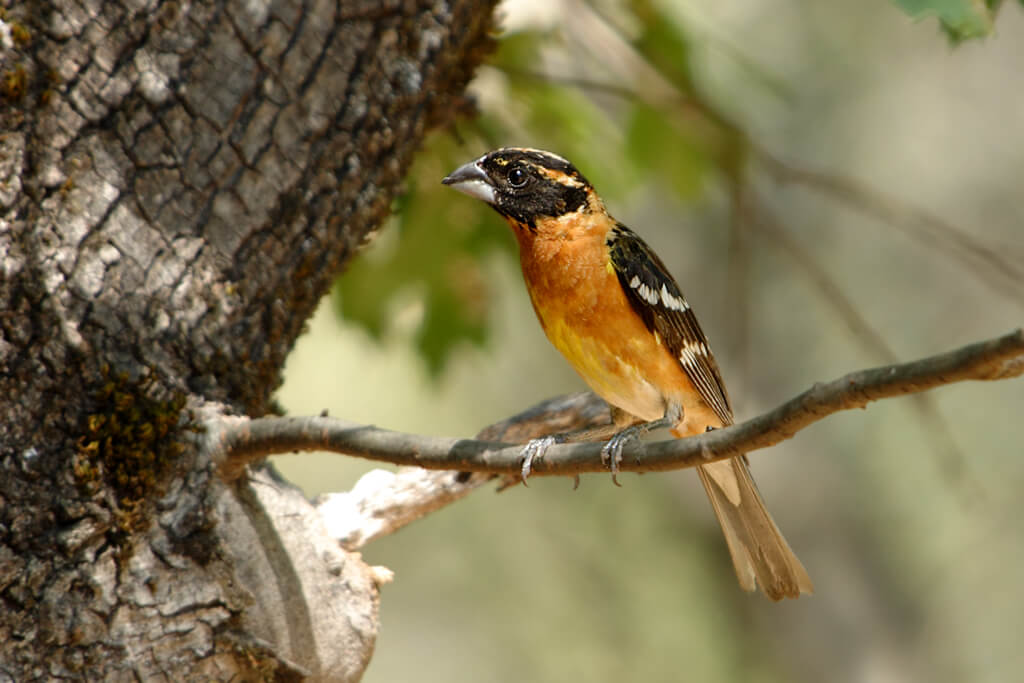
Where do Black-Headed Grosbeaks live?
These birds of North America are primarily found during the breeding season in the western portion of the United States. They are commonly found in large trees in conifer forests, such as cottonwood trees.
Their riparian habitat spans anywhere from Montana, Oregon, and California. While rare, this stunning bird species is sometimes found as far east as Texas and the Great Plains.
When food becomes scarce in the non-breeding season, these mid-range migrants flock to areas such as Central America and Mexico.
Do Black-Headed Grosbeaks Migrate?
The breeding season for the black-headed grosbeak is short. Flocks of these wild birds arrive from their wintering grounds in early to late April and last through early July.
Once they raise a brood of young, these songbirds head south in mid-summer in search of better food sources in Mexico.
The black-headed grosbeak isn’t a long-distance migrant and rarely travels farther than Mexico during the non-breeding season.
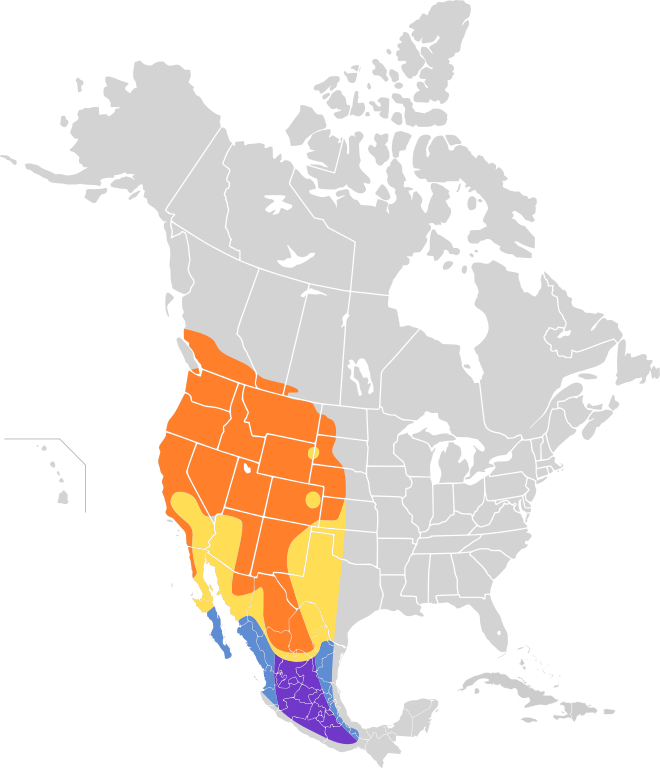
How Long Do They Live?
The oldest recorded black-headed grosbeak lived to be just over 11 years old. The average age of varies and depends upon the climate, available food sources, and exposure to predators.
What About Mating Rituals?
When adult males reach breeding age, they utilize a few tools in their bird toolbelt to attract a mate.
Male black-headed grosbeaks fly into the air to display their bright yellow and orange feathers while reverently singing to attract a mate.
Unlike other songbirds, the male isn’t the only one that sings. The female mimics males’ warbling tunes (albeit much quieter) to attract their attention or persuade them to take turns in the nest.
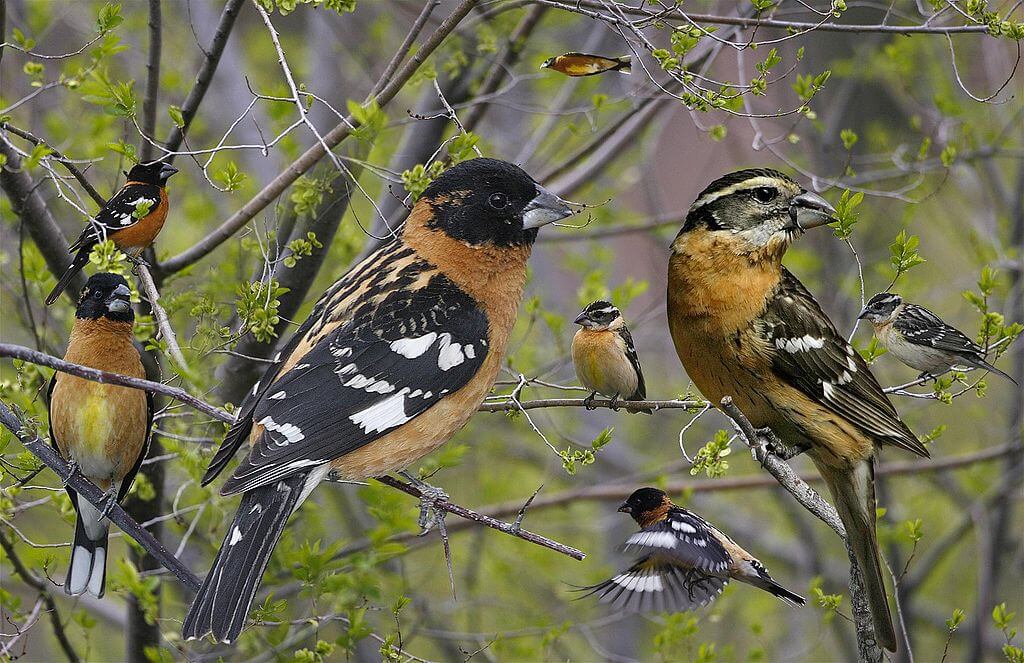
What is the sound of a Black-Headed Grosbeak?
Their warbling mating calls sound very similar to the call of the American robin. However, there are slight differences in the tone, cadence, and pitch.
Some refer to the call of the black-headed grosbeak as a drunk Robin. Its call sounds slurred with many liquid warbling notes and unique phrasing.
Nesting and Eggs
Once the female selects her mate, she begins construction on her nest. Black-headed grosbeak nests comprise nesting materials such as rootlets, twigs, grasses, and pine needles. Nests are loosely made and bulky, despite their shallow cup with linings of soft animal fur.
Nests and perches are positioned at least 10 to 12 feet off the ground, while some are as high as 25 feet in the understory of large trees.
Due to their short breeding season, most of these Passeriformes only lay one brood of eggs per year. While the female can lay up to five eggs per brood, she lays between two to three on average.
Their eggs are a shade of blue with brown spots. Once the eggs are laid, both parents take turns during incubation.
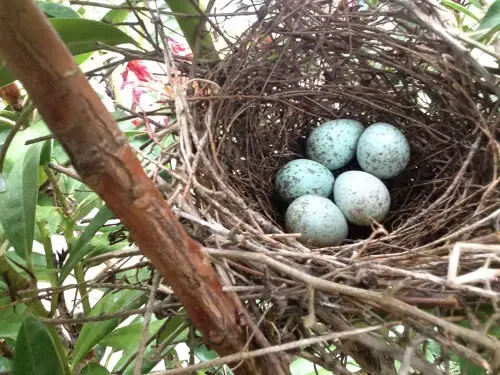
Nestlings and Fledglings
Black-headed grosbeak eggs take up to 14 days to hatch. Unlike other songbirds, both the male and female take turns sitting on the nest. After the eggs hatch, the male and female black-headed grosbeak feed the helpless nestlings. They feed them a protein-rich diet: snails, caterpillars, spiders, and other insects.
Once the nestlings leave the nest; they cannot fly for at least two weeks and depend on their parents for food and protection. Fledglings often perch in treetops waiting for food until they are ready to fly, which typically takes up to 14 days.
The Black-Headed Grosbeak Vs. The Monarch Butterfly
Monarch butterflies are considered toxic for most songbirds because they store a chemical called cardenolides in their abdomen.
The black-headed grosbeak, however, is one of the few songbirds that can stomach this toxic chemical. This makes the black-headed grosbeak the Monarch Butterflies’ biggest natural predator.
How to Attract Black-Headed Grosbeaks to Your Feeder?
If you want to draw the black-headed grosbeak to your feeders (and protect butterflies at the same time!), they are attracted to backyard bird feeders.
Stock your birdfeeder with plenty of sunflower seeds, or opt for a suet feeder with mealworms or other grains that these North American birds love!
What to read next: Rose-Breasted Grosbeak Identification, Range And Photos

